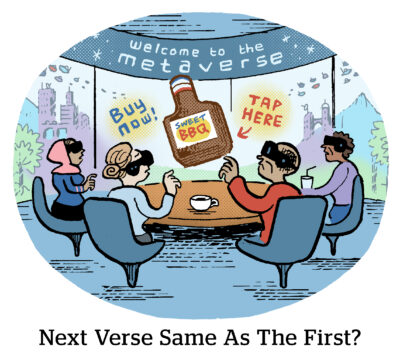Advertisers who are actively testing metaverse marketing had some tough truths for the nascent media channel at the IAB’s Audience Connect event in New York City this week.
For the most part, metaverse early adopters say they’re just exploring the possibilities rather than trying to really demonstrate ROI.
And while hugely popular online games like Roblox and Fortnite are lumped in with metaverse platforms, they’re really Web 2.0 gaming without the decentralized interoperability promised by Web 3.0 and blockchain technology. The few actual metaverse environments in market, such as Decentraland and The Sandbox, don’t offer the audience reach advertisers crave.
Web 2.0 vs. Web 3.0
“Right now, a lot of people conflate the metaverse with virtual worlds,” said Rachel Noonan, director of strategy at ad agency Jam3. The metaverse is an aspirational internet protocol in which interconnected platforms will use blockchain technology to enable the sharing of digital assets, she said.
Web 3.0 is the realization of that aspiration, which is still decades away, said Jessica Berger, VP of innovation at Publicis Media.
When we think of the metaverse today, online gaming platforms like Roblox or massively multiplayer online games like Fortnite come to mind. But these types of interactive and immersive 3D environments are rooted in Web 2.0 infrastructure rather than built on decentralized blockchain technology, which is the hallmark of Web 3.0, Berger said.

For example, Roblox is Web 2.0 because its users can’t transfer the digital assets they’ve purchased on that platform to other virtual environments, said Lauren Griewski, CRO at Web 3.0 advertising platform Permission.io (and a Meta and Roblox alum).
In a Web 3.0 environment, ownership of digital assets – so-called non-fungible tokens (NFTs) – would be accounted for on a blockchain, which is essentially a cross-platform digital ledger.
That means marketing efforts involving purchasable digital assets in Roblox or Fortnite would, strictly speaking, not qualify as true metaverse marketing, even though they are often classified as such. But these hybrid efforts help bridge the gap between Web 2.0 and Web 3.0.
Limited reach
While metaverse spaces are sometimes hyped as a new way to reach younger, hipper audiences, the in-market metaverse platforms do not consistently attract large numbers of active users. Decentraland and The Sandbox, two of the most popular non-Meta metaverse platforms, both draw about 1,000 daily average users.
“Sometimes, there’s like 46 people wandering around. There’s nobody in these platforms,” Noonan said. “Or they’re coming for an occasion or a concert, and then they’re leaving.”
Meanwhile, Meta’s Horizon Worlds boasted 300,000 monthly average users two months after its release in December 2021, but Meta hasn’t released updated user numbers for the platform since February.
Some metaverse-adjacent online games do draw large crowds – like Roblox, which attracts more than 50 million daily average users. But mainstream popularity at that level is nonexistent in true metaverse spaces.

Eric John, VP of the IAB’s Media Center, said he recently tried to show off his Dolce & Gabbana NFT on Decentraland, but no one else was there. If your virtual fit is fresh, but there’s no one around to make some commotion for it, does it really slap?
Metaverse platforms struggle to raise the participation level because users often face complicated setups involving a digital wallet to link with cryptocurrency or NFTs, said Vadim Supitskiy, CTO at Forbes. He stressed that simplification and education are key to getting more users, and thus more brands, involved in the metaverse.
Attribution and brand safety
When it comes to measuring the ROI of metaverse campaigns, “No one’s asking for it,” said Scott Varland, SVP and head of Jack X, North America, for the agency Jack Morton Worldwide. “Everyone’s in this mode of experimenting, but honestly, in the room, when we’re talking about what we’re going to do, ROI is not mentioned.”
But some brands are starting to focus on metaverse marketing attribution. Decentraland offers limited measurement capabilities, and many virtual worlds have commerce integrations that can be attributed, Berger said. But, at this point, metaverse measurement capabilities mostly center on upper-funnel metrics like brand awareness and sentiment, she said.
While the metaverse plan right now may be to raise brand affinity, an experimental channel populated by teenagers can leave brands open to legal and ethical concerns, not to mention PR backlash.
For example, Roblox’s recently launched advertising platform needs to be age-gated because of the platform’s popularity with kids, Noonan said. And whenever brands get involved in new media channels, “consumers are going to roast the brands, regardless of whether brands are on the right side of privacy, safety or ad standards,” she said.
To avoid giving ad haters more ammunition, advertisers and platforms should look to third parties like the Electronic Frontiers Foundation and XRSI for guidance on best practices for user privacy and safety in virtual spaces, Noonan said.
Ultimately, metaverse marketing is still in the trial-and-error stage, so campaigns tend to be “either a wild success or a total flop,” Varland said. “You have to be prepared for some things to go wrong.”













